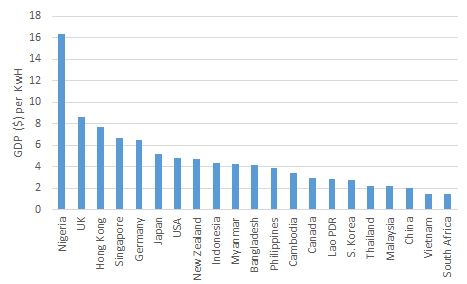Electricity use - surprising cost of generating GDP
/ELECTRICITY CONSUMPTION BY COUNTRY SOURCE: CIA
I saw this story yesterday about the use of electricity by bitcoin. It turns out that bitcoin uses a lot of electricity. More than Switzerland, or 64.15 TwH per year.
This got me started thinking about electricity usage in Vietnam as well, and I realized I had no idea how Vietnam stacked up. It turns out, Vietnam is the 15th largest country in the world by population, but it is ranked #25 according to how much electricity it consumes. That’s based on 2016 figures.
China and the US are numbers #1 and #2, although I was a little surprised that China was already so much further ahead than the US. That’s mainly because it has just so many people. India, despite having a similar number of people, still hasn’t surprised the USA and remains the third largest consumer of electricity.
ELECTRICITY CONSUMPTION PER CAPITA BY SELECT COUNTRIES IN 2016. SOURCE: CIA (ELECTRICITY DATA), WORLD BANK FOR POPULATION
Of course, this is sort of a mix of countries ranked by population but also by how many natural resources the countries have. That’s why a country like the UAE is the 31st largest consumer of electricity, despite being the 92nd largest country in the world. Saudi Arabia is the 41st largest country but consumes more electricity than Italy, which has almost twice the population.
Because of these anomalies, I also looked at KwHs consumed per capita. This is also pretty interesting. Surprisingly, the US is not as bad as I thought they would be. They are 9th in terms of electricity usage per capita. The largest is Iceland, with over 50,000 KwH annually, but that turns out to be mostly aluminum (75% of electricity goes to aluminum manufacturing). Electricity is very cheap and sourced from renewables (86%) in the country, so the fact that the country consumes so much isn’t too problematic. In contrast, the oil- and gas-producing countries are also high on this list, and that is not great for climate change.
GDP (IN CONSTANT US$) PER KWH, 2016. SOURCE: WORLD BANK, CIA
Finally, I looked at the efficiency of electricity to generate GDP. This was interesting, because the countries that do well on this metric are the poorest ones. Chad is number #1 on the list (not on the chart to the right) with $48 in GDP generated from every KwH.
Vietnam is way down on this metric at 179th with $1.43 of GDP generated for every KwH. Nigeria is much higher, as is the UK, Singapore, among others. In fact, of all of ASEAN, Vietnam is the worst. Not really sure why this is. Maybe productivity (but then lots of countries in ASEAN have worse productivity than Vietnam). Maybe the fact that Vietnam is actually pretty electrified, but GDP production in these smaller villages is relatively minimal. Something to look into.
The problem is that Vietnamese electricity prices aren’t especially low, meaning that GDP is being generated at a pretty high cost. Or another way to think of it, more of GDP is going to electricity generation/purchase than in most other countries.




